Answered step by step
Verified Expert Solution
Question
1 Approved Answer
hi, please help me with these questions. please do kot do number 3 as uou can see I already did it. thank you:) Excel Activity:
hi, please help me with these questions. please do kot do number 3 as uou can see I already did it.
Excel Activity: Bond Valuation Clifford Clark is a recent retiree who is interested in investing some of his savings in corporate bonds. His financial planner has suggested the following bonds: - Bond A has a 10% annual coupon, matures in 12 years, and has a $1,000 face value. - Bond B has an 8% annual coupon, matures in 12 years, and has a $1,000 face value. - Bond C has a 6% annual coupon, matures in 12 years, and has a $1,000 face value. Each bond has a yield to maturity of 8%. b. Calculate the price of each of the three bonds. Round your answers to the nearest cent. Price ( Bond A): $ Price (Bond B): $ Price (Bond C): $ c. Calculate the current yield for each of the three bonds. (Hint: The expected current yield is calculated as the annual interest divided by the price of the bond.) Round your answers to two decimal places. Current yield (Bond A): Current yield (Bond B): Current yield (Bond C): d. If the yield to maturity for each bond remains at 8%, what will be the price of each bond 1 year from now? Round your answers to the nearest cent. Price (Bond A): $ Price (Bond B): 5 d. If the yield to maturity for each bond remains at 8%, what will be the price of each bond 1 year from now? Round your answers to the nearest cent. Price ( Bond A): $ Price (Bond B): $ Price (Bond C): $ What is the expected capital gains yield for each bond? What is the expected total return for each bond? Round your answers to two decimal places. e. Mr. Clark is considering another bond, Bond D. It has an 8% semiannual coupon and a $1,000 face value (i.e., it pays a $40 coupon every 6 months). Bond D is scheduled to mature in 7 years and has a price of $1,210. It is also callable in 5 years at a call price of \$1,090. 1. What is the bond's nominal yield to maturity? Round your answer to two decimal places. e. Mr. Clark is considering another bond, Bond D. It has an 8% semiannual coupon and a $1,000 face value (i.e., it pays a $40 coupon every 6 months). Bond D is scheduled to mature in 7 years and has a price of $1,210. It is also callable in 5 years at a call price of $1,090. 1. What is the bond's nominal yield to maturity? Round your answer to two decimal places. % 2. What is the bond's nominal yield to call? Round your answer to two decimal places. % 3. If Mr. Clark were to purchase this bond, would he be more likely to receive the yield to maturity or yleld to cail? Explain your answer. Because the YTM is the YTC. Mr. Clark expect the bond to be called. Consequently, he would earn f. Explain briefly the difference between price risk and reinvestment risk. This risk of a decline in bond values due to an increase in interest rates is called The risk of an income decline due to a drop in interest rotes is called 9. Calculate the price of each bond (A,B, and C) at the end of each year until maturity, assuming interest rates rernain constant. Round your answers to the nearest cent. 1. What is the expected current yield for each bond in each year? Round your answers to two decimal places. 2. What is the expected capital gains yield for each bond in each year? Round your answers to two decimal places. 3. What is the total return for each bond in each year? Round your answers to two decimal places. Excel Activity: Bond Valuation Clifford Clark is a recent retiree who is interested in investing some of his savings in corporate bonds. His financial planner has suggested the following bonds: - Bond A has a 10% annual coupon, matures in 12 years, and has a $1,000 face value. - Bond B has an 8% annual coupon, matures in 12 years, and has a $1,000 face value. - Bond C has a 6% annual coupon, matures in 12 years, and has a $1,000 face value. Each bond has a yield to maturity of 8%. b. Calculate the price of each of the three bonds. Round your answers to the nearest cent. Price ( Bond A): $ Price (Bond B): $ Price (Bond C): $ c. Calculate the current yield for each of the three bonds. (Hint: The expected current yield is calculated as the annual interest divided by the price of the bond.) Round your answers to two decimal places. Current yield (Bond A): Current yield (Bond B): Current yield (Bond C): d. If the yield to maturity for each bond remains at 8%, what will be the price of each bond 1 year from now? Round your answers to the nearest cent. Price (Bond A): $ Price (Bond B): 5 d. If the yield to maturity for each bond remains at 8%, what will be the price of each bond 1 year from now? Round your answers to the nearest cent. Price ( Bond A): $ Price (Bond B): $ Price (Bond C): $ What is the expected capital gains yield for each bond? What is the expected total return for each bond? Round your answers to two decimal places. e. Mr. Clark is considering another bond, Bond D. It has an 8% semiannual coupon and a $1,000 face value (i.e., it pays a $40 coupon every 6 months). Bond D is scheduled to mature in 7 years and has a price of $1,210. It is also callable in 5 years at a call price of \$1,090. 1. What is the bond's nominal yield to maturity? Round your answer to two decimal places. e. Mr. Clark is considering another bond, Bond D. It has an 8% semiannual coupon and a $1,000 face value (i.e., it pays a $40 coupon every 6 months). Bond D is scheduled to mature in 7 years and has a price of $1,210. It is also callable in 5 years at a call price of $1,090. 1. What is the bond's nominal yield to maturity? Round your answer to two decimal places. % 2. What is the bond's nominal yield to call? Round your answer to two decimal places. % 3. If Mr. Clark were to purchase this bond, would he be more likely to receive the yield to maturity or yleld to cail? Explain your answer. Because the YTM is the YTC. Mr. Clark expect the bond to be called. Consequently, he would earn f. Explain briefly the difference between price risk and reinvestment risk. This risk of a decline in bond values due to an increase in interest rates is called The risk of an income decline due to a drop in interest rotes is called 9. Calculate the price of each bond (A,B, and C) at the end of each year until maturity, assuming interest rates rernain constant. Round your answers to the nearest cent. 1. What is the expected current yield for each bond in each year? Round your answers to two decimal places. 2. What is the expected capital gains yield for each bond in each year? Round your answers to two decimal places. 3. What is the total return for each bond in each year? Round your answers to two decimal places thank you:) 
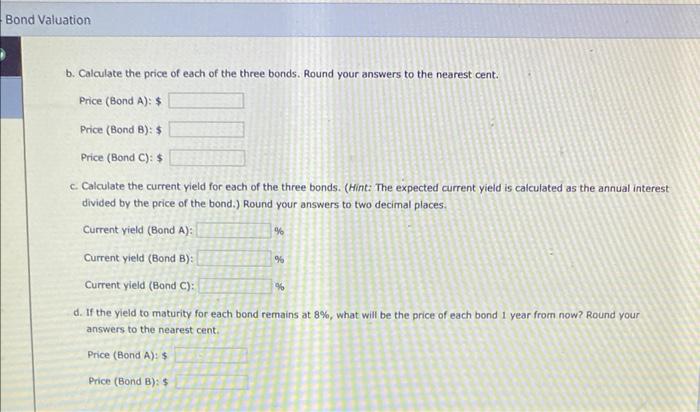
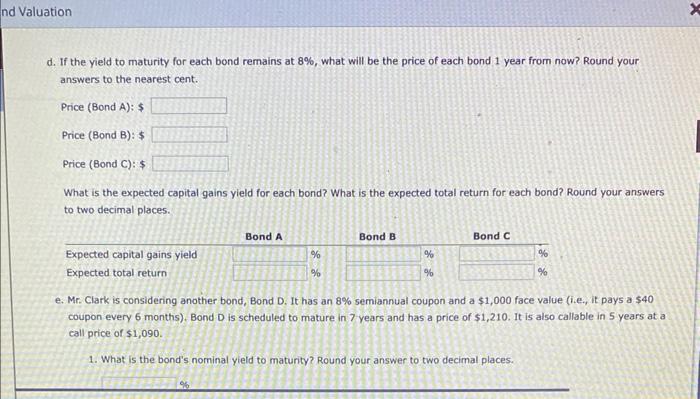
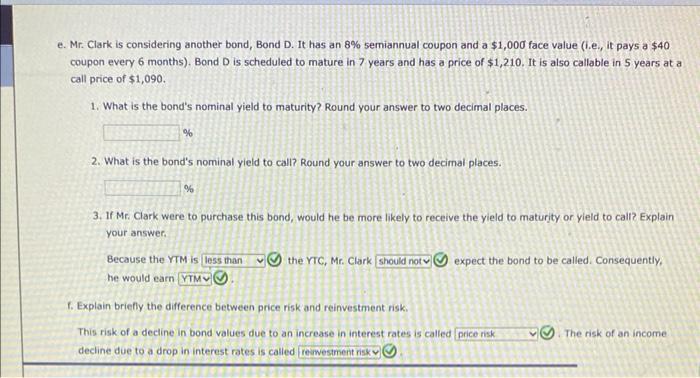
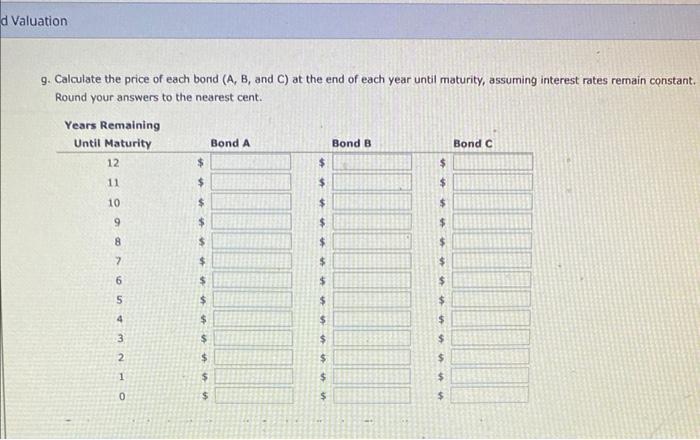

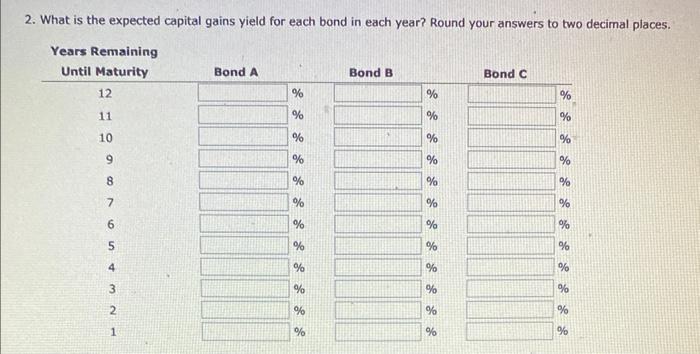
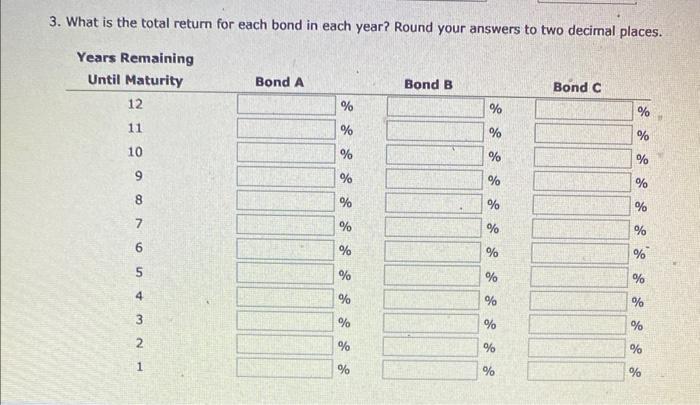








Step by Step Solution
There are 3 Steps involved in it
Step: 1

Get Instant Access to Expert-Tailored Solutions
See step-by-step solutions with expert insights and AI powered tools for academic success
Step: 2

Step: 3

Ace Your Homework with AI
Get the answers you need in no time with our AI-driven, step-by-step assistance
Get Started


